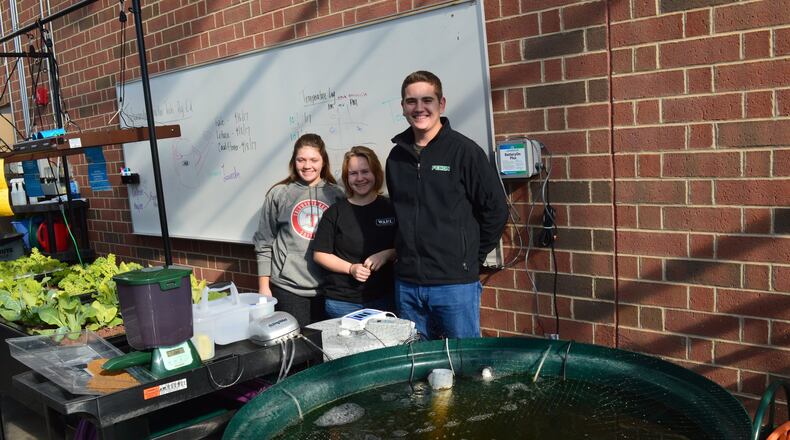MORE: Oxford salon another life step for business owner
It’s all part of the sophomore greenhouse class taught by Kari Roberts, one of the two agriculture teachers and advisors for the Talawanda/Butler Tech FFA program.
The system started with a hydroponics system in the school’s greenhouse where students learned about growing plants without soil but rather using nutrient solutions in water with the roots exposed. Those nutrients come from a variety of sources including fish waste, duck manure and other sources.
That expanded last spring when the class used grant money from Butler Tech and other funding from the school to purchase an aquaponics system to facilitate that growing process.
Now, the hydroponics system sits on one side of the greenhouse aisle and the new aquaponics system rests opposite it, allowing students to use both and learn from each.
MORE: Where to find fresh-cut Christmas trees in Butler, Warren counties
The aquaponics system starts with a large water tank holding fish — tilapia — with tanks and hoses connected to the growing area where cauliflower and kale plants are growing with their roots in nutrient-rich water and no dirt.
“Nutrients from the fish provide nutrients for the plants and filter back to the fish,” Roberts explained of the interrelated aquaponics system.
Setting up the system has not been without its challenges, but the students have tackled each problem with solutions so that it is working as it should for the past few weeks.
“There have been a lot of ups and downs,” said Eliza Jones, one of three students serving as greenhouse managers and involved with setting up the aquaponics system over the summer. “We worked two days, about five hours a day. We had pallets of stuff.”
Student had to assemble the system, wire it, trouble shoot problems, figure out the electronics and, eventually, figure out the right balance of nutrients, measure pH in the water to determine how acidic or alkaline the water is and a problem with foam accumulating on the water.
MORE: Help Butler County kids in need this holiday by donating a teddy bear
“There was a lot that went into it,” said Hannah Lightfield, another of the managers.
The third manager, Justin Beckner echoed that, adding, “There was a lot of trial and error.”
The three were recruited for their manager position last spring when Roberts decided the FFA and agriculture education program needed to find a more active role for sophomores. First-year FFA members, called Greenhands, have their own organization, activities and officer team. Juniors and seniors dominate the FFA program.
“I wanted to give leadership opportunities for a couple of the sophomores,” she said, adding she went to the freshman class of ag instructor Mike Derringer and asked for applications. “Three seemed interested. They came in during the summer and put it together.”
She said the students used a lot of what they had learned about engines, motors and other areas both in the classroom, through FFA and at home to troubleshoot the problems and get the aquaponics system operating.
MORE: Oxford joins coalition planning litigation against state
“The pump went down and they fixed it. They did not just throw it in the trash. They used skills learned at home,” Roberts said.
Michael Schwab, who manages the original hydroponics system with Dalton Schlichter, was part of the team that put the aquaponics system together.
Schwab explained it took a lot of time to get everything set up properly and deal with issues like foamy water and pumps getting plugged up.
“I think it’s pretty fun,” he said. “We had to keep the pH level down.”
The water is cloudy so the fish are not readily visible but they added netting over the tank when four of the original 30 fish managed to jump out of the tank.
Beckner said food for the fish is released on a timer so they receive a predetermined amount at regular intervals.
“The water looks really gross,” he said. It’s healthy. Grossly healthy.”
MORE: 2 longtime Oxford insurance agencies merge
Lightfield explained the water coming from the fish tank moves though a bed of plants not in dirt but in absorbent clay stones which absorb the water and hydrate the plants.
The water then moves to another water tank without the clay stones where the plants are held on a board with their roots down in the tub of water, also absorbing the nutrient-rich water.
The students watched a video about a month ago which helped in some of their troubleshooting.
“We watched the video and said, ‘OK, we did that wrong,’ ” Lightfield said.
Jones said they realized they were lucky to have the aquaponics system, seeing how such a system is used to feed people in Utah and Mexico. Not only can the plants feed people, but the fish raised in the system also become food.
She said the system cost $6,000. They used a grant from Butler Tech for that as well as program funds from Butler Tech.
MORE: Tim Hortons opens first Butler County location: 3 things to know
“Mrs. Roberts wanted an aquaponics program a long time and finally got it,” Jones said, adding the three managers were part of a video demonstration shown at an all-boards meeting at Butler Tech recently. “Hannah, Justin and I went to the all-boards meeting with a mini-system with Beta fish. It was nerve-wracking talking to people but it was really, really important. It was fun.”
Produce raised in the greenhouse is being given to the FCCLA class for their food preparation classes and they hope to have a tilapia meal from the fish in the tank when they have grown large enough for eating.
About the Author
